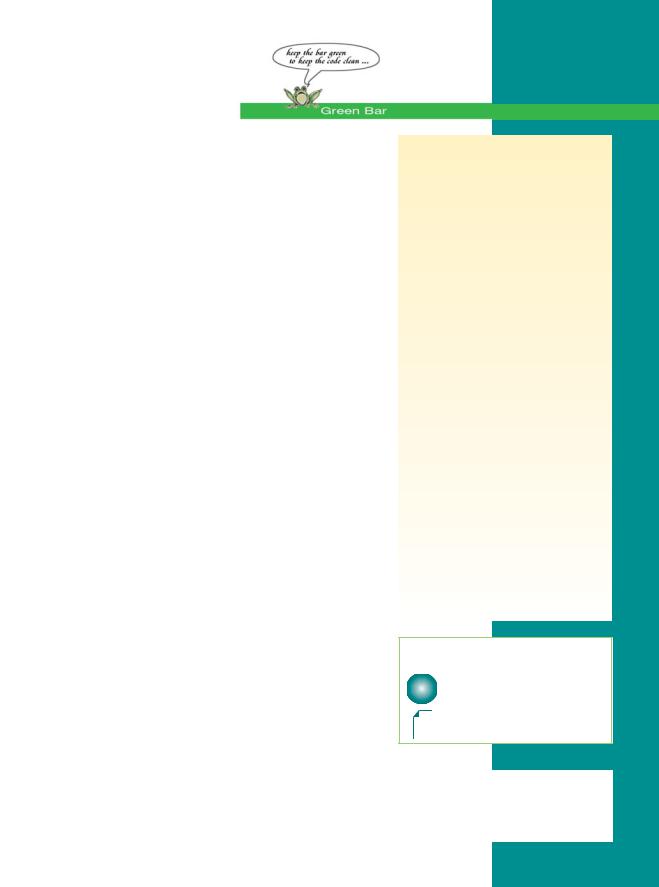
- •contents
- •preface
- •acknowledgments
- •about this book
- •Special features
- •Best practices
- •Design patterns in action
- •Software directory
- •Roadmap
- •Part 1: JUnit distilled
- •Part 2: Testing strategies
- •Part 3: Testing components
- •Code
- •References
- •Author online
- •about the authors
- •about the title
- •about the cover illustration
- •JUnit jumpstart
- •1.1 Proving it works
- •1.2 Starting from scratch
- •1.3 Understanding unit testing frameworks
- •1.4 Setting up JUnit
- •1.5 Testing with JUnit
- •1.6 Summary
- •2.1 Exploring core JUnit
- •2.2 Launching tests with test runners
- •2.2.1 Selecting a test runner
- •2.2.2 Defining your own test runner
- •2.3 Composing tests with TestSuite
- •2.3.1 Running the automatic suite
- •2.3.2 Rolling your own test suite
- •2.4 Collecting parameters with TestResult
- •2.5 Observing results with TestListener
- •2.6 Working with TestCase
- •2.6.1 Managing resources with a fixture
- •2.6.2 Creating unit test methods
- •2.7 Stepping through TestCalculator
- •2.7.1 Creating a TestSuite
- •2.7.2 Creating a TestResult
- •2.7.3 Executing the test methods
- •2.7.4 Reviewing the full JUnit life cycle
- •2.8 Summary
- •3.1 Introducing the controller component
- •3.1.1 Designing the interfaces
- •3.1.2 Implementing the base classes
- •3.2 Let’s test it!
- •3.2.1 Testing the DefaultController
- •3.2.2 Adding a handler
- •3.2.3 Processing a request
- •3.2.4 Improving testProcessRequest
- •3.3 Testing exception-handling
- •3.3.1 Simulating exceptional conditions
- •3.3.2 Testing for exceptions
- •3.4 Setting up a project for testing
- •3.5 Summary
- •4.1 The need for unit tests
- •4.1.1 Allowing greater test coverage
- •4.1.2 Enabling teamwork
- •4.1.3 Preventing regression and limiting debugging
- •4.1.4 Enabling refactoring
- •4.1.5 Improving implementation design
- •4.1.6 Serving as developer documentation
- •4.1.7 Having fun
- •4.2 Different kinds of tests
- •4.2.1 The four flavors of software tests
- •4.2.2 The three flavors of unit tests
- •4.3 Determining how good tests are
- •4.3.1 Measuring test coverage
- •4.3.2 Generating test coverage reports
- •4.3.3 Testing interactions
- •4.4 Test-Driven Development
- •4.4.1 Tweaking the cycle
- •4.5 Testing in the development cycle
- •4.6 Summary
- •5.1 A day in the life
- •5.2 Running tests from Ant
- •5.2.1 Ant, indispensable Ant
- •5.2.2 Ant targets, projects, properties, and tasks
- •5.2.3 The javac task
- •5.2.4 The JUnit task
- •5.2.5 Putting Ant to the task
- •5.2.6 Pretty printing with JUnitReport
- •5.2.7 Automatically finding the tests to run
- •5.3 Running tests from Maven
- •5.3.2 Configuring Maven for a project
- •5.3.3 Executing JUnit tests with Maven
- •5.3.4 Handling dependent jars with Maven
- •5.4 Running tests from Eclipse
- •5.4.1 Creating an Eclipse project
- •5.4.2 Running JUnit tests in Eclipse
- •5.5 Summary
- •6.1 Introducing stubs
- •6.2 Practicing on an HTTP connection sample
- •6.2.1 Choosing a stubbing solution
- •6.2.2 Using Jetty as an embedded server
- •6.3 Stubbing the web server’s resources
- •6.3.1 Setting up the first stub test
- •6.3.2 Testing for failure conditions
- •6.3.3 Reviewing the first stub test
- •6.4 Stubbing the connection
- •6.4.1 Producing a custom URL protocol handler
- •6.4.2 Creating a JDK HttpURLConnection stub
- •6.4.3 Running the test
- •6.5 Summary
- •7.1 Introducing mock objects
- •7.2 Mock tasting: a simple example
- •7.3 Using mock objects as a refactoring technique
- •7.3.1 Easy refactoring
- •7.3.2 Allowing more flexible code
- •7.4 Practicing on an HTTP connection sample
- •7.4.1 Defining the mock object
- •7.4.2 Testing a sample method
- •7.4.3 Try #1: easy method refactoring technique
- •7.4.4 Try #2: refactoring by using a class factory
- •7.5 Using mocks as Trojan horses
- •7.6 Deciding when to use mock objects
- •7.7 Summary
- •8.1 The problem with unit-testing components
- •8.2 Testing components using mock objects
- •8.2.1 Testing the servlet sample using EasyMock
- •8.2.2 Pros and cons of using mock objects to test components
- •8.3 What are integration unit tests?
- •8.4 Introducing Cactus
- •8.5 Testing components using Cactus
- •8.5.1 Running Cactus tests
- •8.5.2 Executing the tests using Cactus/Jetty integration
- •8.6 How Cactus works
- •8.6.2 Stepping through a test
- •8.7 Summary
- •9.1 Presenting the Administration application
- •9.2 Writing servlet tests with Cactus
- •9.2.1 Designing the first test
- •9.2.2 Using Maven to run Cactus tests
- •9.2.3 Finishing the Cactus servlet tests
- •9.3 Testing servlets with mock objects
- •9.3.1 Writing a test using DynaMocks and DynaBeans
- •9.3.2 Finishing the DynaMock tests
- •9.4 Writing filter tests with Cactus
- •9.4.1 Testing the filter with a SELECT query
- •9.4.2 Testing the filter for other query types
- •9.4.3 Running the Cactus filter tests with Maven
- •9.5 When to use Cactus, and when to use mock objects
- •9.6 Summary
- •10.1 Revisiting the Administration application
- •10.2 What is JSP unit testing?
- •10.3 Unit-testing a JSP in isolation with Cactus
- •10.3.1 Executing a JSP with SQL results data
- •10.3.2 Writing the Cactus test
- •10.3.3 Executing Cactus JSP tests with Maven
- •10.4 Unit-testing taglibs with Cactus
- •10.4.1 Defining a custom tag
- •10.4.2 Testing the custom tag
- •10.5 Unit-testing taglibs with mock objects
- •10.5.1 Introducing MockMaker and installing its Eclipse plugin
- •10.5.2 Using MockMaker to generate mocks from classes
- •10.6 When to use mock objects and when to use Cactus
- •10.7 Summary
- •Unit-testing database applications
- •11.1 Introduction to unit-testing databases
- •11.2 Testing business logic in isolation from the database
- •11.2.1 Implementing a database access layer interface
- •11.2.2 Setting up a mock database interface layer
- •11.2.3 Mocking the database interface layer
- •11.3 Testing persistence code in isolation from the database
- •11.3.1 Testing the execute method
- •11.3.2 Using expectations to verify state
- •11.4 Writing database integration unit tests
- •11.4.1 Filling the requirements for database integration tests
- •11.4.2 Presetting database data
- •11.5 Running the Cactus test using Ant
- •11.5.1 Reviewing the project structure
- •11.5.2 Introducing the Cactus/Ant integration module
- •11.5.3 Creating the Ant build file step by step
- •11.5.4 Executing the Cactus tests
- •11.6 Tuning for build performance
- •11.6.2 Grouping tests in functional test suites
- •11.7.1 Choosing an approach
- •11.7.2 Applying continuous integration
- •11.8 Summary
- •Unit-testing EJBs
- •12.1 Defining a sample EJB application
- •12.2 Using a façade strategy
- •12.3 Unit-testing JNDI code using mock objects
- •12.4 Unit-testing session beans
- •12.4.1 Using the factory method strategy
- •12.4.2 Using the factory class strategy
- •12.4.3 Using the mock JNDI implementation strategy
- •12.5 Using mock objects to test message-driven beans
- •12.6 Using mock objects to test entity beans
- •12.7 Choosing the right mock-objects strategy
- •12.8 Using integration unit tests
- •12.9 Using JUnit and remote calls
- •12.9.1 Requirements for using JUnit directly
- •12.9.2 Packaging the Petstore application in an ear file
- •12.9.3 Performing automatic deployment and execution of tests
- •12.9.4 Writing a remote JUnit test for PetstoreEJB
- •12.9.5 Fixing JNDI names
- •12.9.6 Running the tests
- •12.10 Using Cactus
- •12.10.1 Writing an EJB unit test with Cactus
- •12.10.2 Project directory structure
- •12.10.3 Packaging the Cactus tests
- •12.10.4 Executing the Cactus tests
- •12.11 Summary
- •A.1 Getting the source code
- •A.2 Source code overview
- •A.3 External libraries
- •A.4 Jar versions
- •A.5 Directory structure conventions
- •B.1 Installing Eclipse
- •B.2 Setting up Eclipse projects from the sources
- •B.3 Running JUnit tests from Eclipse
- •B.4 Running Ant scripts from Eclipse
- •B.5 Running Cactus tests from Eclipse
- •references
- •index

index
Numerics
302 response code (redirect) 73
A
abstract classes, testing 311 AbstractHttpHandler method
(Jetty) 128 AbstractHttpListener class
(Jetty) 128
acceptance testing 6, 71, 75–76 Account class 82, 141–145 account transfer testing 141 AccountManager interface
141–143 AccountService.transfer
method 141, 143–146 add method 7–8 addAccount method 144 addHandler method 42, 50,
60, 128 addTest method 23
addTestSuite method 24 Administration
application 188–189, 216, 240, 261
administrators 188 AdminServlet
Administration application and 216
DataAccessManager and 244–247
refactoring 243–244 testing with Cactus 189–192
agile methodologies 68 Algol 68
alternate path of execution See failures
Ant
book 93
build process management with 92
build system choice with 315 build.properties file 94, 317 buildfiles 91, 93–94, 98,
101–102 cactification 266
cactifywar task 266–271, 329 cactus task 333
cactus testing with 265–274 Cactus/Ant integration
module 265–274, 329 configuration of 91 database integration testing
and 261 ear task 317
fileset element 100 installing 91–92, 98 Java application building
tool 91–92 javac task 94–96
JDBC query invoking with 91 junit jar 98
junit task 96–98, 100–101, 272, 322, 333
junitreport task 98–100 parallel task 321 project XML tag and 93 properties of 94 property elements 93
property task 94
retaining test results with 27 SQL task 266
targets 93, 101–102 taskdef element 273 tasks 93
WAR task 266 web site 91
AOP (Aspect-Oriented Programming) 173
Apache test server 124
APIs (Application Programming Interface)
contract defined 6 methods 81
testing of public 72, 78 verifying behavior of 171 application.xml file 315, 317–
318, 331 architecture patterns 41
Aspect Oriented Programming (AOP) 173
AspectJ jar 177 aspectjrt.jar 270
assertEquals method 14, 31, 131, 134, 153, 219, 250
AssertionException 256 AssertionFailedError 159 assertSame 54
Avalon framework 149
B
BaseTestRunner class 21 BasicDynaClass class 219–220
351

352 INDEX
batchtest element 272 beanutils.RowSetDynaClass 247 Beck, Kent 5, 40, 70, 164,
166, 240 beginIsAuthenticatedNoSession
method 181 best practices
business logics and mocks 144
Cactus tests, location of 176 code improvement with
testing 60, 62 continuous regression
testing 86
exception test readability 62 failure explanation in assert
calls 51
packaging and directory locations of test classes 64
refactor long setups when using mock objects 254
refactor test setups and teardowns 299 refactoring and agile
methodologies 68 test method naming 50
throw an exception for methods that aren’t implemented 204
unit test one object at a time 48
unit tests and testMethods 53 use TDD to implement The Simplest Thing That
Could Possibly Work 197 verification of test failure 192 what to test 56, 145
black box testing 78, 81 body tag 228 BodyContent class 230 BodyTagSupport class 229 bottlenecks, finding with
profilers 74 branches, conditional 78 Brunner, John 89
build cactus.xml buildfile 329 build.properties file 111, 317 buildfiles (Ant) 91, 93–94, 97–
98, 101–102 Bureau of Extreme
Programming 45
business logic unit tests 144, 280 ByteArrayISO8859Writer class
(Jetty) 128
C
C2 Wiki 163
cactification 192, 267, 270– 271, 331
Cactus
Ant integration 266–267, 328 DbUnit integration 271–273 defined 173, 267
directory structure for tests 329
EJB unit tests 328 FileRedirector 212 front ends 179
in-container testing with 166, 173–183
integration with Jetty 175–178 jars 177
JSP testing 217–218, 238, 331, 333
mock objects compared to 213, 216, 237, 278
running tests 174–175 setInitParameter method 211 task 273
taskdef 270
test runners 174–178 testing filters 208–213 testing life cycles 179–180,
230–233
testing taglibs 224–233, 237 testing under Jetty with
Eclipse 177
testing under Maven 196 web sites 166, 267, 274 when to use 213–214, 216,
237, 278 XML and 329–331
cactus.jar 270 Cactus/Ant integration
module 266–267 cactus-ant integration jar 267 Calculator class 6–7 CalculatorTest program 8–10 callView method 189, 198, 200–
201, 242 Carroll, Lewis 282
Centipede 315
class factory refactoring 156 classloaders 10, 12
classpath 94, 97–98, 177, 270, 272
classpath element 96 clean build 92
CLEAN INSERT strategy 264 clean target 101
clearCache method 307 close calls 258
close method 159 Clover 79–80
coarse-grained testing 121 code issues 146 codesmell 62 collaboration tags, testing
of 233
collecting parameters 25–27 Common Public License 5 CommonMockStatement 251 CommonPetstoreTestCase 305–
306, 309 Commons-HttpClient jar 177 Commons-Logging jar 177 compile targets 95–96, 268 compile.cactustest target 269 compile.test target 319 condition task 321 conditional branches 78
Connection object 248–249, 258 ConnectionFactory class
156–157
Container Managed Persistence (CMP) 282–283
container-related code testing 167
continuous integration 179, 279–280
controller component 40–45 Controller interface 41–42 controller object 50 Controller project 116 countTestCases method 30 Craig, Philip 140
create method 307 createCommandResult
method 201 createdb target 267–268
createOrder method 283, 286– 287, 290, 293, 297, 303, 314

INDEX 353
createOrderHelper method 290, 293
cron job 99 Cunningham, Ward 75 custom taglibs 216 customer
always right 62
D
data access unit tests types of 241
data.sql file 266 data.xml 263–264, 270
DataAccessManager class 262 DataAccessManager
interface 243, 247 database
access layer interface implementation 243
access unit tests 241, 278 connection pooling 241 connectivity 29, 258, 260,
263–264 constraints 260 features 242, 260 in-memory 278
integration testing 260–264, 279–280
queries 261
referential integrity 260 schema 266–267 triggers 260
unit-testing 240–242, 260–274 DatabaseTestSetup 275–276 DataSource
implementation 262 DbUnit
adding jar 273
Cactus integration 272 database data presetting
with 263
database testing and 242, 260–261
web site 260 dbunit.jar 270 DefaultAccountManager
class 147–149 DefaultController 43, 45, 48,
79, 91 DefaultJMSUtil class 294
DefaultOrderUtil class 294 definitions
acceptance tests 6 API contract 6 component 167 container 167 domain object 47 expectation 159 fixture 29 framework 5 integration tests 6 mock object 141 refactor 52 regression tests 90 stub 121
Test-Driven Development 81 unit of work 5
unit test 6 dependency in software
development 120 deployment
automatic 319 descriptors 173, 238, 313,
318, 331 ears 333 targets 319
Design by Contract website 6 design patterns
collecting parameters 27 command pattern 25 composite pattern 25 Factory 134
Interfaces 164
Inversion of Control 42, 149, 155, 164
MVC Model 2 199 observer 28
development cycle 82 diagnostic tests 55
directory structure 63, 105, 111, 315, 329
dist target 101
doAfterBody method 229, 231 document root 125–126 doEndTag method 226, 228 doGet method 201–204, 206,
242, 246 domain object 47–48
doStartTag method 226–228 doubles 7
duplication eliminating 83
dyna beans 218–220 DynaBean class 199 DynaBeans 219, 225–226 dynamic proxies 167 Dynamic Proxy 204, 233, 238 DynaMock
EasyMock compared to 204 testing session beans with 284 writing mocks with 246
DynaPropertiesTag class 225
E
ear files 315–317, 319–321, 329, 331, 333
EasyMock 167–170, 204 Eclipse
adding jars 177
Cactus testing under Jetty with 177
plug-ins 175, 234
projects 113, 115, 175–177 Quick Fixes 191
test results retention with 27 TestDefaultController, run-
ning with 114 web site 112
EJB
defining sample applications 282
façade strategies 283–284 home caching issue 306 limitations of JUnit with 314 local interfaces 328, 334 Redirectors 328
remote interface testing 314 remote interfaces 314
unit test writing with Cactus 328
unit testing with Cactus 329 ejbCreate method 311–312 EJBException class 293 ejb-jar.xml file 315 ejb-local-ref element 330 Electric XML 271 eliminating duplication 83 Emacs 112
embedded servers 124 endCallView method 221 entity beans 282, 310 EntityBean class 310

354 INDEX
error conditions 56, 152 error handling 26, 56, 152 errorproperty attributes 322 ErrorResponse class 44, 79 Example TimedTest class 75 exceptions 42, 55–56, 60
execute method 248–250, 257– 258, 261
executeCommand method 189, 198, 201, 242
executeQuery method 251 exml.jar 271 expectAndReturn method 293 expectAndThrow method 307 expectations 159, 163, 256 Extreme Programming 5, 197
F
fail statements 61 failureproperty attributes 322 failures 51, 56–57, 132–133, 258 field getters/setters and absolute
classes 311 fileset element 101 filesystem 126
FilterChain 209–210, 212 FilterConfig 209, 212 filters 188, 208, 314 FilterTestCase 182 findAccountForUser
method 142–144, 147, 149 findAncestorWithClass
method 233 fit framework
web site 75 Fixtures 50
controller object created by default 58
defined 29 de-initializing with
tearDown 32 long and complex 254
test case sharing of 53–54 TestSetup 129, 134, 145, 275–
276, 297–298 fork attribute 97 formatter element 272 Fowler, Martin 4 framework 4–5 Freeman, Steve 140
functional testing 71–72, 76, 171, 261, 279, 283
G
Galileo 120 Gamma, Erich 112 Gang of Four 5
Generate Getters and Setters feature 311
getBalance method 82 getColumnCount method 254–
255
getCommand method 189–191, 197–198, 242–243
getConnection method 249, 258
getContent method (WebClient) 122
getHandler method 44, 47, 60, 79
getInputStream method 136– 137, 153
getMetaData method 254–255 getName method 55 getOrder method 287 getOrderHome method 287,
306
getOrderId method 292–293 getParameter method 206 getParent method 233 getRequest method 50 getRequestDispatcher
method 220 Giraudoux, Jean 140 green-bar tests 21
H
haltonerror attribute 97, 272 haltonfailure attribute 96–97,
272
Handler class (Jetty) 127–128 Hashtable 144
Heisenberg Uncertainty
Principle 155
Hollywood Principle 42 hsqldb.jar 268
HTML DOM 222
HTTP clients 40
connection mock objects 150 connections 122–123, 150–
151, 181 cookies 181–182 elements 40
headers 40, 181–182, 222 parameters 40, 216, 225 protocols 157
HTTP requests AdminServlet
requirements 189 doGet method entry point
for 242
functional unit tests using 73 HTTPContext processing
of 126 HTTP-related parameters
in 181
interception by the security filter 216
receipt by application 188 using Cactus to add SQL com-
mand to 210
web controller acceptance 40 HTTP response 128, 182, 210,
212, 222, 225, 230 HTTP sessions 40, 181, 225 httpclient.jar 270 HttpConnectionFactory class
157 HttpContext 126
HttpContext class 125–126, 129, 132–133
HttpRequest class 128–129 HttpResponse class 127, 133 HttpServer class 125, 129–130,
132
HttpServer class (Jetty) 125 HttpServlet class 166, 168, 242,
245
HttpServletRequest class 166, 168–170, 181, 205
HttpServletResponse class 181, 220
HttpSession class 166, 168–170, 181
HttpSocketListener class (Jetty) 129

INDEX 355
HttpUnit class 167, 217, 221, 225
HttpURLConnection class 123, 133–134, 136–138, 153, 157
HttpURLConnection interface 123
Hypersonic SQL 260, 278, 315, 324
I
IDE (integrated development environments) 56, 112
IEEE 5 IllegalStateException 298 incomplete mock object
test 251
in-container testing 166, 173, 178
InitialContext class 285, 297– 298, 314
inner classes 48 InputStream class 159 integrated development envi-
ronments (IDE) 56, 112 integration testing 6, 71–72,
133–134, 283 integration unit testing
comparison with logic and functional unit testing 76, 172
database testing with 242, 260–264, 279–280
defined 76, 172–173 EJBs and 313 errors in 323–325 execution time 179
J2EE testing with 166
mock objects approach compared to 179–180
with Cactus and JUnit 334 interactions between objects 81 introspect method 253
invalid URLs 132–133 Inversion of Control
(IOC) 148–149 isAuthenticated method 166,
168–169, 173
isolation testing 134, 140, 150, 164, 217
It Works! return 127–128, 130
J
J2EE
component unit testing 166–167
containers 260, 315 integration issues, costs
of 279
jar proliferation 109
Java Complier (javac) 94–96 Java IDE’s 112
Java Messaging Service (JMS) 283–284
Java Naming and Directory Interface (JNDI) 284–285, 297–307, 314
Java Server Pages (JSP) 188– 189, 216–233
Java Virtual Machine (JVM) 96, 320
JAVA_HOME 92 JavaBean 56
javac (Java Compiler) 94–96 Javadocs 14, 23, 30, 92, 102 JBoss
development 320 Hypersonic SQL and 260,
315, 324 installing 317 JNDI and 326 version 3.2.1 273 website 317
jboss.xml file 326 jboss3x element 273 jbossresult.txt file 273
JDBC 91, 120, 141, 145–147, 284 JdbcDataAccessManager
class 243–244, 247, 249– 250, 261–262
JEdit 112 Jeffries, Ron 148 Jester 80
Jetty
benefits of 124–125, 138, 175 Cactus testing under, with
Eclipse 177
embedded server used as 125 handler that returns 127 Handlers 127–128 JettySample class 125 modularity 125
NotFoundHandler 132 opening a URL 125 pros 125
setting up stubs with 124–125 starting and stopping 129 starting from code 125–127 website 124
Jetty classes AbstractHttpHandler 127–
129, 133 ByteArrayISO8859Writer 128 Handler 128–129 HttpContext 125, 129 HttpServer 125
HttpServer class 129 JettySample 125 SocketListener 125, 129
Jetty methods addHandler 128 handle 128 setContextPath 126 setResourceBase 126 setUpandtearDown 127
JMeter 73
JMS (Java Messaging Service 283–284
JMSException class 293 JMSUtil class 287, 294–295, 303 JMSUtil interface 295, 297 JNDI (Java Naming and Direc-
tory Interface) 284–285, 297–307, 314
JNDI API 188 jndi.properties file 297 JNDINames class 326 JNDITestSetup 298 Joyce, James 18 JspRedirector class 224
JSPs (JavaServer Pages) 216 JspTagLifecycle class 228, 230 JspTestCase class 182, 224–225,
227, 230 JSTL 219, 226 JUnit
Assert interface 30 core classes 19–20 core members 19 design goals 15, 24, 30 FAQ 56
features 13 IDEs and 112

356 INDEX
JUnit (continued) life cycle 37–38 motto 20 overview 5
Test interface 23 JUnit classes
BaseTestRunner class 20, 22 TestCase class 13, 18, 25,
28, 31 TestFailure class 25
TestListener interface 27 TestResults class 25 TestRunner class 18, 20, 180 TestSuite class 18, 21–23, 131
JUnit methods
assertEquals method 13–14, 30, 126
JUnit TestClass constructors version 3.8.1 and later 15
junit.jar file 98 JUnitEE website 314 JUnitPerf website 74 JUnitReport 99
JVM (Java Virtual Machine) 32, 96, 320
K
Kawasaki, Guy 66
L
Log interface 147 Log object 146 Log4j 109
LoggerFactory class 146 logging.jar 270
logic unit tests 76, 172, 241 lookup method 287
M
Mackinnon, Tim 140 Marick, Brian 216
matchAndReturn method 293, 307
Maven artifacts 109
cactification 192 compared to Ant and
Eclipse 90, 112
configuring 103–105 dependency handling 108–109 directory structure 193, 212 goal seeking 102, 109 handling dependent jars 109 HTML reports 196
ID element 105 IDEs and 112 installing 103 JUnit test with 109
JUnit testing with 109 maven-linkcheck-plugin 106 PATH 103
plugins 102–103, 105–106, 109, 192, 196
portability 103 project configuration
files 222
project description 104 Project Object Module (POM) 104–108 project.xml 108–109, 196
reports element 108 repositories 109
running Cactus tests 192–193, 212–213
url element 105 version element 105 website 102
website generation with 105–108
welcome page 106–107 workflow 109
maven site 109 MAVEN_HOME 103 maven-changelog-report 106 MavenLJUnit test with 109 mergewebxml attribute 330 Message Driven Beans
(MDB) 282–283, 307–310 metadata 173, 218, 238, 313 Method Factory refactoring 155 Mock DataAccessManager 246 mock objects
as probes 159
as Trojan horses 159 benefits of 140
best practices 254
Cactus compared to 213, 216, 237, 278
defined 141
entity beans, testing with 310–312
finding methods to mock 250 HTTP connection and
150–159
in-container testing with 166 indirect calls, discovery of 253 JNDI implementation
stragegy 297, 303, 309 making generic 144 making mocks generic 144 message-driven bean
testing 308 mocking at a different
level 254 practical example 150
pros and cons 144, 170–171 real objects compared to 163 servlet testing with 167–170 session beans 284–285 standard JDK APIs 163
stubs compared to 120, 141, 144
web site 163
when to use 121, 138, 163, 213–214
white box tests and 78, 81 MockAccountManager
class 143–144 MockConfiguration class 149 MockConnectionFactory
class 157, 160 MockHttpURLConnection
class 153 MockInputStream class 159 MockLog class 149 MockMaker 234, 237–238 MockMultiRowResultSet
class 252
MockObject JDBC package 247 MockObjects
framework SQL package 280 jar 112
project web site 163 MockSingleRowResultSet
class 252 MockURL class 150, 153 monumental
methodologies 197 Murphy’s Law 56

INDEX 357
MVC Model 2 199
N
name property 42 Newton 25
O
objective standards 77 openConnection method 134 optional.jar file 98
Oracle 278
OrderEJB class 310–312 OrderFactory class 295 OrderProcessMDB 314 OrderProcessorMDB class 286 OrderUtil class 286, 303,
306–307
OrderUtil interfaces 294 Orion 171, 273
P
PageContext class 224, 234, 238 Pascal 68
performance testing 74 Petstore application 314–315 Petstore OrderEJB class 314 PetstoreEJB class 285, 289–291,
295, 303, 314 play-testing 4
POJO (Plain Old Java Object) 212, 283 POM (project object model) 104–108
pre-test state 50
printsummary attribute 97, 272 process method 42, 49 processRequest method 42, 44,
51, 57, 79
production environments, drawbacks in testing 124
profilers 73
project directory structure 265 project object model
(POM) 104–108 project.xml file 104 PropertyResourceBundle
class 147 ProtocolException 136
proxy redirector 180 pushBody method 230
Q
QA teams 75
R
read-only data, factoring 275 red-bar tests 21, 58
redirect 302 response code 73 refactoring 244
best practice 60
class factory, used for 155–159 courage for 68
defined 52
easy method technique for 152–155
extract hierarchy 62 extract method 62 making code unit-testable
with 69, 283 Method Factory 155
mock objects used as technique for 146–149
natural solution 245 PetstoreEJB 294 renaming 294 sample 58–59
setDataAccessManager 245 suite of unit tests, benefits
for 140 TDD two-step 83
referential integrity 260 reflection and introspection 10 regression testing 86, 90–91 report target 100
Request 209, 212 Request interface 41, 58 RequestDispatcher 208
RequestHandler class 42, 47, 49–50
RequestHandler interface 41 Resin 273
Response 209, 212
response code (302) redirect 73 Response interface 41, 44 results.jsp 218
ResultSet interface 248, 251 RowSetDynaClass 247
run method 30 RuntimeException class 44, 58,
60, 314
S
Sample servlet 166 Sampling project buildfiles
93, 96 scriptlets 189
Security error page 211 security filter 216 SecurityFilter class 208 SecurityFilter Filter 208 SELECT queries 216 SELECT statement 206, 208,
250 sendToJMSQueue method
286, 303 sendToJMSQueueHelper
method 290 sequence diagrams 33 Service Level Agreement
(SLA) 188 Servlet class 180 ServletConfig 181
ServletRedirector 179, 181 ServletRedirector class 180 ServletRequest 208 ServletResponse 208 servlets
API 188
containers 125, 189, 223, 273 Pet Store sample 283 remote web resources as 122 sample method for unit
testing 166
server side code that calls EJBs 314
testing a method 166 unit testing 188 writing tests for using
Cactus 189 ServletTestCase class
Cactus and 180, 182, 217 extending with
TestAdminServlet 190, 200
presetting database data with 261–262
ServletUnit 167

358 INDEX
SessionBean class 290, 295 setConnection method 250 setContextPath method 125 setDataAccessManager
method 245–246 setDoInput method 136 setExpectedCloseCalls
method 256 setExpectedQueryString 256 setInitialContextFactoryBuilder
method 297–298 setJMSUtil method 293, 297 setOrderFactory method 297 setOrderUtil method 293 setPageContext method 224,
227
setParent method 227, 233 setResourceBase method 125 setUp methods 126–128, 130 setURLStreamHandlerFactory
method 134 simulations, using tests to
create 57, 133, 150 SLA (Service Level
Agreement) 188 SocketListener class 125, 133 software accidents 72 software, testing 71 sortHTMLTable tag 228 SortHtmlTableTag class 228 SQL
commands 210 queries 189, 208–211 statements 208
standard output 8 start target 319
stateless session beans 283 Statement class 248
static modifier 294 stepwise refinement 68 stop target 319
stored procedures 242 strategies/techniques for testing
adjusting build failure criteria 79
Cactus in-container 167, 213–214
choosing an appropriate 260–264
creating a component class 249
creating a wrapper class 249 database access layer 244 exploring alternative 58 façade 283–284
factory class 285, 293, 303, 312
factory method 285, 289, 303, 309, 312
mock 297
mock JNDI 285, 297–307, 309, 312
mock object 140–141, 151, 213, 313
stubbing 120–121, 124, 138 stress/load testing 71–75, 261 Strong, William 188
Struts 40, 77, 199, 219 StubHttpURLConnection
class 136 StubHttpURLStreamHandler
class 134 stubs
choosing 124–125 compared to mock
objects 120, 138, 141, 144
creating sophisticated tests with 64
how to use 121 overview 120–121 pros and cons 121
replacing real code with 122 sample use of 121–124 stubbing connections
134–138 stubbing web server’s
resources 126–134 when to use 121, 138 white box testing and 81
StubStreamHandlerFactory class 134
subclasses, replacing with collaborators 156
suite method 34 Swing applications 283
T
tag life cycle testing
method 227–228, 230–233 taglibs (tag libraries) 188, 216
Body tag container life cycle 230
EJB calling with 314 unit testing with Cactus
224–233
unit testing with mock objects 233–237
TagSupport class 225 TDD (Test Driven Develop-
ment)
automatic documentation 69 avoiding interface overdesign
with 44
best practice principle using 60
core tenets 83 defined 81 design process 82
effective adjustment to conventional development cycle 82
elimination of refactoring code in unit testing enabling with 164
initial step of 89 reference book about 164 Test First 189
writing tests before writing code 189
teams, working with 120, 140 tearDown method 126–130 terrific trio 18–19
Test class, writing the 131 Test Driven Development (TDD) See TDD (Test Driven Development)
test runners 11–12, 21, 26–27, 277
TestableJdbcDataAccessManager class 249
TestableOrderEJB 311 TestablePetstoreEJB class 291–
292
TestableWebClient class 154 TestAccount 82 TestAccount class 82 TestAccountService 144 TestAccountService class 144 testAddHandler method 52 TestAdminServlet 190, 200
|
|
INDEX |
|
359 |
|
|
|
|
|
TestAdminServlet class 192, 196, |
TestExceptionHandler class 57 |
TestRunner class 18, 20, 180 |
||
199, 219 |
testExecuteCloseConnectionOn |
TestRunners |
|
|
TestAdminServletDynaMock |
Exception 258 |
Cactus and 174, 180 |
||
246 |
testExecuteOk method 256 |
combining with a TestSuite 24 |
||
TestAdminServletMO class 205 |
TestFailure class 25 |
defined 19 |
|
|
TestAll class 24 |
testGetBalanceOk method 82 |
defining 21 |
|
|
TestCalculator class 13, 34 |
testGetContentOk class 153 |
failures and 25–26 |
|
|
TestCalculator program 18, |
testGetContentOk method 154, |
launching tests with 20–21 |
||
22, 25 |
158, 161–162 |
read-only database data |
||
TestCalculator walk-through 33 |
TestGetContentOkHandler |
and 277 |
|
|
TestCallView 201 |
class 127, 129 |
running graphical and text 11 |
||
TestCase class 61 |
testGetOrderHomeFromCache |
selecting 20 |
|
|
TestCases 131 |
method 306 |
tests |
|
|
collecting results from 25 |
test-infected programs 4, 45, 70 |
comparison of 172 |
|
|
defined 20 |
testing |
composit and command pat- |
||
extending from JUnit 13 |
as first customer 62 |
terns and 25 |
|
|
extracting from JUnit 13 |
challenges 120 |
coverage 67, 79–80 |
|
|
fixtures and 29 |
components 167 |
fine-grained 164 |
|
|
for PetStoreEJB 295 |
database access 241 |
folders 64 |
|
|
grouping for |
database logic 241 |
simulation cases 293 |
||
performance 277 |
effectiveness 102 |
targets 93, 96, 101, 273, 321 |
||
how to group 22 |
fine-grained 164, 173 |
types of 71–77, 172 |
|
|
objects, adding to Test |
in isolation 129, 150, 164 |
TestSampleServlet 168 |
||
Suites 18, 25 |
inside the container 167 |
TestSampleServletIntegration |
||
requirements for 29 |
live database 260 |
class 173, 180 |
|
|
running several at once 18 |
outside the container 167 |
TestSetup 128–131, 134, 145, |
||
test interface and 23 |
performance turning 275 |
275–276, 297–299 |
||
TestSampleServletIntegration |
prime objective 214 |
TestSetup class 129 |
|
|
180 |
strategies 121 |
TestSortHtmlTableTag 230 |
||
typical 29 |
TestJdbcDataAccessManagerIC |
testSubtract method 23 |
||
working with 28–32 |
261 |
TestSuite class 18, 21–23, 131 |
||
writing the 299–303 |
TestJdbcDataAccessManagerIC2 |
TestSuites |
|
|
TestClass constructors version |
276 |
composing tests with 21–25 |
||
3.8.1 16, 22 |
TestJdbcDataAccess- |
customizing 23–25 |
|
|
testCreateOrderOk method 299 |
ManagerMO1 class 250 |
defined 19–20 |
|
|
testCreateOrderThrowsCreate- |
TestJdbcDataAccess- |
TestCustomerAll 277 |
||
Exception method 306 |
ManagerMO3 255 |
TestJdbcDataAccessManager |
||
testCreateOrderThrowsExcep- |
TestOrderEJB 311, 328 |
276 |
|
|
tion method 306 |
TestOrderProcessorMDB 309 |
TestSetup and 128 |
|
|
testCreateThrowsOrderExcep- |
TestOrderUtil class 305 |
TestWebClient1 131 |
||
tion method 299 |
TestPetStoreEJB 299 |
TestWebClient class 134, 137, |
||
TestCustomerAll 277 |
TestPetstoreEJB class 292, 295, |
150, 158 |
|
|
TestCustomerAll class 277 |
325 |
TestWebClient test case 122 |
||
TestDefaultController class 46, |
TestPetstoreEJB.java file 315 |
TestWebClient1 class |
131 |
|
49–57, 101, 114 |
testProcessRequest method 52, |
TestWebClientSetup1 class 129, |
||
Test-Driven Development |
54 |
131 |
|
|
(TDD) |
TestRequest class 57–58 |
TestWebClientSkeleton |
||
failures and 192 |
constructor 59 |
class 126 |
|
|
TestDynaPropertiesMO 234 |
TestRequestHandler 57 |
TestWebSetup1 class 132 |
||
TestDynaPropertiesTag |
TestResponse class 49, 51, 54 |
TextPad 112 |
|
|
class 227 |
TestResult 25, 27 |
Tomcat 171, 192, 273 |
|
|

360 INDEX
too simple to break 7, 228 tools for analysis and
reporting 79 transfer method 144 transparency 123 trap doors 148, 151 trial and error 250 triggers 242 try/catch block 10, 61 try/finally block 258
U
UML 33
unit of work 5, 7 unit testing
application life cycle 76 as first-class users 146
co-dependent tests, problems with 32
core tenet of 7 defined 6
description of a typical 6 drawbacks of 166 flavors 76
functional 76–77 integration 76 interaction 76 logic 76
need for 66–69
old school 146 running 20
UNIX 91, 103 updateAccount method 144
URL interface unavailability 153 URLConnection interface 123 URLStreamHandler class 134 URLStreamHandlerFactory
class 134
V
verify method 256 version attribute 330
W
War plugin 222 war target 268 wars, creating 268 web application 222 web servers 124 WebClass methods
getContent 150 WebClient
refactored using ConnectionFactory 156
refactored using MockConnectionFactory 158
testing for failure conditions 132–133
verification for failure conditions 126
WebClient methods getContent 122, 150, 158 getHttpConnection 154 setHttpURLConnection 154
WebLogic 273 WebRequest class 224
WebResponse class 219, 224, 232
white box testing 76, 78, 81 Windows 91, 103
Wirth, Nikolas 68 writing a failing test 83
X
XDoclet 282, 318 XP2000 140 xPetstore application
web site 282 XSL stylesheet 99 xUnit 5
Y
YAGNI 68

JAVA
JUnit IN ACTION
Vincent Massol with Ted Husted
evelopers in the know are switching to a new testing strategy—
Dunit testing—in which coding is interleaved with testing. This powerful approach results in better-designed software with
fewer defects and faster delivery cycles. Unit testing is reputed to give developers a kind of “high”—whenever they take a new programming step, their confidence is boosted by the knowledge that every previous step has been confirmed to be correct.
JUnit in Action will get you coding the new way in a hurry. As inevitable errors are continually introduced into your code, you'll want to spot them as quickly as they arise. You can do this using unit tests, and using them often. Rich in real-life examples, this book is a discussion of practical testing techniques by a recognized expert. It shows you how to write automated tests, the advantages of testing a code segment in isolation from the rest of your code, and how to decide when an integration test is needed. It provides a valuable— and unique—discussion of how to test complete J2EE applications.
What’s Inside
Testing in isolation with mock objects
In-container testing with Cactus
Automated builds with Ant and Maven
Testing from within Eclipse
Unit testing
Java apps |
Filters |
Servlets |
EJB |
JSP |
DB apps |
Taglibs |
|
Vincent Massol is the creator of the Jakarta Cactus testing framework and an active member of the Maven and MockObjects development teams. He is CTO of Pivolis, a specialist in agile offshore software development. Vince lives in the City of Light—Paris, France.
The keep the bar green frog logo is a trademark of
Object Mentor, Inc. in the United States and other countries.
“... captures best practices for effective JUnit and in particular J2EE testing. Don’t unit test your J2EE applications without it!”
—Erich Gamma, IBM OTI Labs
Co-author of JUnit
“Outstanding job... It rocks— a joy to read! I recommend it wholeheartedly.”
—Erik Hatcher, co-author of
Java Development with Ant
“Brings the mass of information out there under one coherent umbrella.”
—J. B. Rainsberger, leader in the JUnit community, author
“Doesn’t shy from tough cases ...
Vince really stepped up, rather than side-stepping the real problems people face.”
—Scott Stirling, BEA
www.manning.com/massol
|
AUTHOR |
Author responds to reader questions |
||
|
|
|
||
|
ONLINE |
|
||
|
|
|
|
Ebook edition available |
|
|
|
|
|
|
|
|
|
|
|
|
|
|
|
|
|
|
|
|
|
|
|
|
|
|
|
|
|
|
|
|
|
|
|
,!7IB9D0-bbajjb!:p;n;T;T;p
M A N N I N G $39.95 US/$59.95 Canada
ISBN 1-930110-99-5
